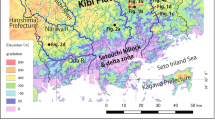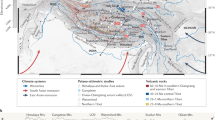Abstract
Northward subduction of the Cenozoic Tethys ocean caused the convergence and collision of Eurasia-Indian Plates, resulting in the lower crust thickening, the upper crust thrusting, and the Qinghai-Tibet uplifting, and forming the plateau landscape. In company with uplifting and northward extruding of the Tibetan plateau, the contractional tectonic deformations persistently spread outward, building a gigantic basin-range system around the Tibetan plateau. This system is herein termed as the Circum-Tibetan Plateau Basin-Range System, in which the global largest diffuse and the most energetic intra-continental deformations were involved, and populations of inheritance foreland basins or thrust belts were developed along the margins of ancient cratonic plates due to the effects of the cratonic amalgamation, crust differentiation, orogen rejuvenation, and basin subsidence. There are three primary tectonic units in the Circum-Tibet Plateau Basin-Range System, which are the reactivated ancient orogens, the foreland thrust belts, and the miniature cratonic basins. The Circum-Tibetan Plateau Basin-Range System is a gigantic deformation system and particular Himalayan tectonic domain in central-western China and is comparable to the Tibetan Plateau. In this system, northward and eastward developments of thrust deformations exhibit an arc-shaped area along the Kunlun-Altyn-Qilian-Longmenshan mountain belts, and further expand outward to the Altai-Yinshan-Luliangshan-Huayingshan mountain belts during the Late Cenozoic sustained collision of Indo-Asia. Intense intra-continental deformations lead ancient orogens to rejuvenate, young foreland basins to form in-between orogens and cratons, and thrusts to propagate from orogens to cratons in successive order. Driven by the Eurasia-Indian collision and its far field effects, both deformation and basin-range couplings in the arc-shaped area decrease from south to north. When a single basin-range unit is focused on, deformations become younger and younger together with more and more simple structural styles from piedmonts to craton interiors. In the Circum-Tibetan Plateau Basin-Range System, it presents three segmented tectonic deformational patterns: propagating in the west, growth-overthrusting in the middle, and slip-uplifting in the east. For natural gas exploration, two tectonic units, both the Paleozoic cratonic basins and the Cenozoic foreland thrust belts, are important because hydrocarbon in central-western China is preserved mainly in the Paleozoic cratonic paleo-highs and the Meso-Cenozoic foreland thrust belts, together with characteristics of multiphrase hydrocarbon generation but late accumulation and enrichment.
Similar content being viewed by others
References
Allegre C J, Courtillat V, Tapponnier P, et al. 1984. Structure and evolution of Himalaya-Tibet orogenic belt. Nature, 307: 17–22
Bally A W, Snelson S. 1980. Realms of Subsidence. In: Miall A D, ed. Facts and Prinlciples of World Petroleum Occurrence. Calgary: Can Soc Pet Geol Mem, 6: 9–94
Charreau J, Chen Y, Gider S, et al. 2005. Magnetostratigraphy and rock magnetism of the Neogene Kuitunhe Section (Northwest China): Implications for Late Cenozoic uplift of the Tianshan Mountains. Earth Planet Sci Lett, 230: 117–192
Chen H L, Yang S F, Xiao A C, et al. 2006. Deformation characteristics and time of Cenozoic thrust belt in southern margin of Jiuquan basin (in Chinese). Oil Gas Geol, 27: 488–494
Cui J W, Zhang X W, Tang Z M. 2006. Tectonic divisions of the Qinghai-Tibet Plateau and structural characteristics of deformation on their boundaries (in Chinese). Geol China, 3: 256–267
Dewey J F, Burke K. 1973. Tibetan variscan and pre-Cambrian basement reactivation: Products of continental collision. Geology, 81: 683–692
Graham S A, Hendrix M S, Wang L B, et al. 1993. Collisional successor basin of western China: Impact of tectonic inheritance on sand composition. Geol Soc Am Bull, 105: 323–344
Guo Z J, Deng S T, Wei G Q, et al. 2007. Comparative study of the foreland thrust belts of South and North Tianshan and implications for hydrocarbon accumulation (in Chinese). Earth Sci Front, 14: 123–131
Guo Z J, Zhang Z C, Wu C D, et al. 2006. The Mesozoic and Cenozoic exhumation history of Tianshan and comparative studies to the Junggar and Altai Mountains (in Chinese). Acta Geol Sin, 80: 1–15
Harrison T M, Copeland P, Kidd W S F, et al. 1992. Raising Tibet. Science, 255: 1663–1670
Hendrix M S, Dumitru T A, Graham S A. 1994. Late Oligocene-Early Miocene un-roofing in the Chinese Tien Shan: An early effect of the India-Asia collision. Geology, 22: 487–490
Jia C Z, He D F, Shi X, et al. 2006. Characteristics of China’s oil and gas pool formation in latest geological history (in Chinese). Sci China Ser D-Earth Sci, 36: 412–420
Jia C Z, Wei G Q, Li B L. 2005. Superimposed-composite characteristics of micro-craton basins and its bearing petroleum systems, Central-Western China (in Chinese). Geol J China Univ, 11: 479–492
Jia C Z, Wei G Q, Yao H J, et al. 1995. Tectonic Evolution and Regional Structural Geology in the Tarim Basin (in Chinese). Beijing: Petroleum Industry Press. 174
Jia C Z, Yang S F, Chen H L, et al. 2001. Structural Geology and Natural Gas in Northern Margin Basin Group of the Tethys (in Chinese). Beijing: Petroleum Industry Press. 162
Jia C Z, Yang S F, Wei G Q, et al. 2008. Structure characteristics and petroleum bearing prospects of Cenozoic Circum Tibet Plateau Basin and Range System in China (in Chinese). Nat Gas Ind, 28: 1–11
Jia C Z. 1997. Tectonic Characteristics and Petroleum, Tarim Basin, China. Beijing: Petroleum Industry Press. 295
Jia C Z. 2005. Foreland thrust-fold belt features and gas accumulation in Midwest China (in Chinese). Pet Explor Dev, 32: 9–15
Jia C Z. 2007. The characteristics of intra-continental deformation and hydrocarbon distribution controlled by the Himalayan tectonic movements in China (in Chinese). Earth Sci Front, 14: 96–104
Jia C Z. 2009. The structures of Basin and Range System around the Tibetan Plateau and the distribution of oil and gas in the Tarim Basin (in Chinese). Geotect Metall, 33: 1–9
Jolivet M, Brunel M, Seward D, et al. 2001. Mesozoic and Cenozoic tectonics of the northern edge of the Tibetan Plateau: Fission-track constraints. Tectonophysics, 343: 111–134
Li B L, Chen Z X, Lei Y L, et al. 2011. Structural geology correlation of foreland thrust-folded belts between the southern and northern edges of the Tianshan Mountain and some suggestions for hydrocarbon exploration (in Chinese). Acta Petrol Sin, 32: 395–403
Li B L, Jia C Z, Pan X Q, et al. 2007. The Spatial Distribution of the Foreland Thrust Tectonic Deformation in the Circum-Tibetan Plateau Basin and Range System (in Chinese). Acta Geol Sin, 81: 1200–1207
Li B L, Lei Y L, Chen Z X, et al. 2011. The neo-tectonic deformation features in the eastern segment of Circum-Tibetan Plateau Basin and Range System: Take the western Sichuan basin as an example (in Chinese). Acta Petrol Sin, 27: 636–644
Li C Y. 1982. Explanatory Notes to the Tectonic Map of Asia. Beijing: Geological Publishing House. 95
Lu H F, Howell D G, Jia D. 1994. Rejuvenation of the Kuqa foreland basin, northern flank of the Tarim basin, Northwest China. Int Geol Rev, 36: 1151–1158
Molnar P, England P, Martinod J. 1993. Mantle dynamics, uplift of the Tibet Plateau, and the Indian monsoon. Rev Geophys, 31: 357–396
Molnar P, Tapponnier P. 1975. Cenozoic tectonics of Asia: Effects of a continental collision. Science, 189: 419–426
Pan G T, Chen Z L, Li X Z, et al. 1997. Geological-tectonic Evolution in the Eastern Tethys (in Chinese). Beijing: Geological Publishing House. 218
Qiu Z J, Gong Z S. 1999. Oil and Gas Exploration in China (Volume I) (in Chinese). Beijing: Petroleum Industry Press. 194
Tapponnier P, Peltzer G, Ledain A Y, et al. 1982. Propagating extrusion tectonics in Asia: New insights from simple experiments with plastic. Geology, 10: 611–616
Tapponnier P, Xu Z Q, Roger F, et al. 2001. Oblique stepwise rise and growth of the Tibet Plateau. Science, 94: 1671–1677
Wang L, Xiao A C, Gong Q L, et al. 2010. The unconformity in Miocene sequence of western Qaidam Basin and its tectonic significance. Sci China Earth Sci, 53: 1126–1133
Wang Q, Zhang P Z, Freymueller J T, et al. 2001. Present day crustal deformation in China constrained by global positioning system measurements. Science, 294: 574–577
Xiao X C, Tang Y Q, Li J Y, et al. 1991. Tectonic Evolution of the Southern Margin of the Paleo-Asian Composite Megasuture (in Chinese). Beijing: Beijing Science and Technology Press. 150
Yang S F, Jia C Z, Chen H L, et al. 2002. Tectonic evolution of Tethyan tectonic field, formation of Northern Margin basin and explorative perspective of natural gas in Tarim Basin. Chin Sci Bull, 47(Supp): 34–41
Yin A, Harrison T M. 2000. Geologic evolution of the Himalayan-Tibetan Orogen. Annu Rev Earth Planet Sci, 28: 211–280
Zhang K. 1991. Discussion of divergence, drifting, collision and convergence of Chinese plates and development of petroleum basin (in Chinese). Xinjiang Pet Geol, 12: 91–106
Zhang P Z, Zhen D W, Yin G M, et al. 2006. Discuss in late Cenozoic growth and rise of northeastern margin of the Tibetan Plateau (in Chinese). Quat Sci, 26: 5–13
Zhu X. 1986. Structure of Petroliferous Basins in China (in Chinese). Beijing: Petroleum Industry Press. 132
Author information
Authors and Affiliations
Corresponding author
Rights and permissions
About this article
Cite this article
Jia, C., Li, B., Lei, Y. et al. The structure of Circum-Tibetan Plateau Basin-Range System and the large gas provinces. Sci. China Earth Sci. 56, 1853–1863 (2013). https://doi.org/10.1007/s11430-013-4649-7
Received:
Accepted:
Published:
Issue Date:
DOI: https://doi.org/10.1007/s11430-013-4649-7




